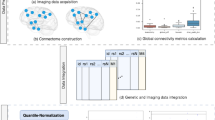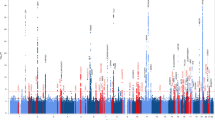Abstract
In addition to senile plaques, neurofibrillary tangles are characteristic of Alzheimer's disease (AD) pathology, suggesting a clear involvement of the microtubule-associated protein tau (MAPT) in AD. Recent findings, suggesting that the H1c haplotype is associated with increased risk, now also implicate MAPT genetically. In this study, we aim to clarify this association by a fine mapping approach using both a traditional phenotypic association analysis and a quantitative trait (QT) analysis using cerebrospinal fluid (CSF) tau protein levels in the German population. Here, we report that both methodologies identify that the H1c haplotype may play important role in AD (AD risk, P=0.007, uncorrected; CSF tau levels, P=0.027, uncorrected). Further, the use of a sliding window approach in the QT analysis allowed for the narrowing down of the region where a probable causal variant may be located. The data suggest that this may lie at or within close proximity to the rs242557 single nucleotide polymorphism as association with CSF tau levels seems to be primarily driven by rs242557 in a gene dosage-dependent manner (trend model: P=0.002, uncorrected). These findings provide functional evidence to support the genetic association of MAPT with AD.
This is a preview of subscription content, access via your institution
Access options
Subscribe to this journal
Receive 12 print issues and online access
$259.00 per year
only $21.58 per issue
Buy this article
- Purchase on Springer Link
- Instant access to full article PDF
Prices may be subject to local taxes which are calculated during checkout



Similar content being viewed by others
References
Spillantini MG, Goedert M . Tau protein pathology in neurodegenerative diseases. Trends Neurosci 1998; 21: 428–433.
Hirokawa N . Microtubule organization and dynamics dependent on microtubule-associated proteins. Curr Opin Cell Biol 1994; 6: 74–81.
Ebneth A, Godemann R, Stamer K, Illenberger S, Trinczek B, Mandelkow E . Overexpression of tau protein inhibits kinesin-dependent trafficking of vesicles, mitochondria, and endoplasmic reticulum: implications for Alzheimer's disease. J Cell Biol 1998; 143: 777–794.
Munoz DG, Dickson DW, Bergeron C, Mackenzie IR, Delacourte A, Zhukareva V . The neuropathology and biochemistry of frontotemporal dementia. Ann Neurol 2003; 5 (Suppl 54): S24–S28.
McKhann GM, Albert MS, Grossman M, Miller B, Dickson D, Trojanowski JQ . Clinical and pathological diagnosis of frontotemporal dementia: report of the Work Group on Frontotemporal Dementia and Pick's Disease. Arch Neurol 2001; 58: 1803–1809.
Kertesz A, McMonagle P, Blair M, Davidson W, Munoz DG . The evolution and pathology of frontotemporal dementia. Brain 2005; 128: 1996–2005.
Lee VM, Goedert M, Trojanowski JQ . Neurodegenerative tauopathies. Annu Rev Neurosci 2001; 24: 1121–1159.
Hutton M, Lendon CL, Rizzu P, Baker M, Froelich S, Houlden H et al. Association of missense and 5′-splice-site mutations in tau with the inherited dementia FTDP-17. Nature 1998; 393: 702–705.
Spillantini MG, Bird TD, Ghetti B . Frontotemporal dementia and Parkinsonism linked to chromosome 17: a new group of tauopathies. Brain Pathol 1998; 8: 387–402.
Baker M, Litvan I, Houlden H, Adamson J, Dickson D, Perez-Tur J et al. Association of an extended haplotype in the tau gene with progressive supranuclear palsy. Hum Mol Genet 1999; 8: 711–715.
Pastor P, Ezquerra M, Tolosa E, Munoz E, Marti MJ, Valldeoriola F et al. Further extension of the H1 haplotype associated with progressive supranuclear palsy. Mov Disord 2002; 17: 550–556.
Pittman AM, Myers AJ, Duckworth J, Bryden L, Hanson M, Abou-Sleiman P et al. The structure of the tau haplotype in controls and in progressive supranuclear palsy. Hum Mol Genet 2004; 13: 1267–1274.
Pittman AM, Myers AJ, Abou-Sleiman P, Fung HC, Kaleem M, Marlowe L et al. Linkage disequilibrium fine mapping and haplotype association analysis of the tau gene in progressive supranuclear palsy and corticobasal degeneration. J Med Genet 2005; 42: 837–846.
Green EK, Thaker U, McDonagh AM, Iwatsubo T, Lambert JC, Chartier-Harlin MC et al. A polymorphism within intron 11 of the tau gene is not increased in frequency in patients with sporadic Alzheimer's disease, nor does it influence the extent of tau pathology in the brain. Neurosci Lett 2002; 324: 113–116.
Russ C, Powell JF, Zhao J, Baker M, Hutton M, Crawford F et al. The microtubule associated protein Tau gene and Alzheimer's disease – an association study and meta-analysis. Neurosci Lett 2001; 314: 92–96.
Myers AJ, Kaleem M, Marlowe L, Pittman AM, Lees AJ, Fung HC et al. The H1c haplotype at the MAPT locus is associated with Alzheimer's disease. Hum Mol Genet 2005; 14: 2399–2404.
Pastor P, Ezquerra M, Perez JC, Chakraverty S, Norton J, Racette BA et al. Novel haplotypes in 17q21 are associated with progressive supranuclear palsy. Ann Neurol 2004; 56: 249–258.
Oliveira SA, Scott WK, Zhang F, Stajich JM, Fujiwara K, Hauser M et al. Linkage disequilibrium and haplotype tagging polymorphisms in the Tau H1 haplotype. Neurogenetics 2004; 5: 147–155.
Skipper L, Wilkes K, Toft M, Baker M, Lincoln S, Hulihan M et al. Linkage disequilibrium and association of MAPT H1 in Parkinson disease. Am J Hum Genet 2004; 75: 669–677.
Pittman AM, Myers AJ, Abou-Sleiman P, Fung HC, Kaleem M, Marlowe L et al. Linkage disequilibrium fine-mapping and haplotype association analysis of the tau gene in progressive supranuclear palsy and corticobasal degeneration. J Med Genet 2005; 42: 837–846.
Rademakers R, Melquist S, Cruts M, Theuns J, Del-Favero J, Poorkaj P et al. High-density SNP haplotyping suggests altered regulation of tau gene expression in progressive supranuclear palsy. Hum Mol Genet 2005; 14: 3281–3292.
Crawford F, Freeman M, Town T, Fallin D, Gold M, Duara R et al. No genetic association between polymorphisms in the Tau gene and Alzheimer's disease in clinic or population based samples. Neurosci Lett 1999; 266: 193–196.
Lilius L, Froelich Fabre S, Basun H, Forsell C, Axelman K, Mattila K et al. Tau gene polymorphisms and apolipoprotein E epsilon4 may interact to increase risk for Alzheimer's disease. Neurosci Lett 1999; 277: 29–32.
Bullido MJ, Aldudo J, Frank A, Coria F, Avila J, Valdivieso F . A polymorphism in the tau gene associated with risk for Alzheimer's disease. Neurosci Lett 2000; 278: 49–52.
Roks G, Dermaut B, Heutink P, Julliams A, Backhovens H, Van de Broeck M et al. Mutation screening of the tau gene in patients with early-onset Alzheimer's disease. Neurosci Lett 1999; 277: 137–139.
Kwok JB, Teber ET, Loy C, Hallupp M, Nicholson G, Mellick GD et al. Tau haplotypes regulate transcription and are associated with Parkinson's disease. Ann Neurol 2004; 55: 329–334.
Iqbal K, Grundke-Iqbal I . Mechanism of Alzheimer neurofibrillary degeneration and the formation of tangles. Molec Psychiatry 1997; 2: 178–180.
McKhann G, Drachman D, Folstein M, Katzman R, Price D, Stadlan EM . Clinical diagnosis of Alzheimer's disease: report of the NINCDS-ADRDA Work Group under the auspices of Department of Health and Human Services Task Force on Alzheimer's Disease. Neurology 1984; 34: 939–944.
Roth M, Tym E, Mountjoy CQ, Huppert FA, Hendrie H, Verma S et al. CAMDEX. A standardised instrument for the diagnosis of mental disorder in the elderly with special reference to the early detection of dementia. Br J Psychiatry 1986; 149: 698–709.
Welsh KA, Butters N, Mohs RC, Beekly D, Edland S, Fillenbaum G et al. The Consortium to Establish a Registry for Alzheimer's Disease (CERAD). Part V. A normative study of the neuropsychological battery. Neurology 1994; 44: 609–614.
Folstein MF, Folstein SE, McHugh PR . ‘Mini-mental state’. A practical method for grading the cognitive state of patients for the clinician. J Psychiatr Res 1975; 12: 189–198.
Zivelin A, Rosenberg N, Peretz H, Amit Y, Kornbrot N, Seligsohn U . Improved method for genotyping apolipoprotein E polymorphisms by a PCR-based assay simultaneously utilizing two distinct restriction enzymes. Clin Chem 1997; 43: 1657–1659.
Blennow K, Wallin A, Agren H, Spenger C, Siegfried J, Vanmechelen E . Tau protein in cerebrospinal fluid: a biochemical marker for axonal degeneration in Alzheimer disease? Mol Chem Neuropathol 1995; 26: 231–245.
Riemenschneider M, Blennow K, Wagenpfeil S, Andreasen N, Prince JA, Laws SM et al. The cathepsin D rs17571 polymorphism: effects on CSF tau concentrations in Alzheimer disease. Hum Mutat 2006; 27: 532–537.
Barrett JC, Fry B, Maller J, Daly MJ . Haploview: analysis and visualization of LD and haplotype maps. Bioinformatics 2005; 21: 263–265.
Zaykin DV, Westfall PH, Young SS, Karnoub MA, Wagner MJ, Ehm MG . Testing association of statistically inferred haplotypes with discrete and continuous traits in samples of unrelated individuals. Hum Hered 2002; 53: 79–91.
Stephens M, Smith NJ, Donnelly P . A new statistical method for haplotype reconstruction from population data. Am J Hum Genet 2001; 68: 978–989.
Stephens M, Donnelly P . A comparison of bayesian methods for haplotype reconstruction from population genotype data. Am J Hum Genet 2003; 73: 1162–1169.
Lambert JC, Goumidi L, Vrieze FW, Frigard B, Harris JM, Cummings A et al. The transcriptional factor LBP-1c/CP2/LSF gene on chromosome 12 is a genetic determinant of Alzheimer's disease. Hum Mol Genet 2000; 9: 2275–2280.
Schahab S, Heun R, Schmitz S, Maier W, Kolsch H . Association of polymorphism in the transcription factor LBP-1c/CP2/LSF gene with Alzheimer's disease and major depression. Dement Geriatr Cogn Disord 2006; 22: 95–98.
Williams DW, Tyrer M, Shepherd D . Tau and tau reporters disrupt central projections of sensory neurons in Drosophila. J Comp Neurol 2000; 428: 630–640.
Wittmann CW, Wszolek MF, Shulman JM, Salvaterra PM, Lewis J, Hutton M et al. Tauopathy in Drosophila: neurodegeneration without neurofibrillary tangles. Science 2001; 293: 711–714.
Jackson GR, Wiedau-Pazos M, Sang TK, Wagle N, Brown CA, Massachi S et al. Human wild-type tau interacts with wingless pathway components and produces neurofibrillary pathology in Drosophila. Neuron 2002; 34: 509–519.
Mudher A, Shepherd D, Newman TA, Mildren P, Jukes JP, Squire A et al. GSK-3beta inhibition reverses axonal transport defects and behavioural phenotypes in Drosophila. Mol Psychiatry 2004; 9: 522–530.
Chee FC, Mudher A, Cuttle MF, Newman TA, MacKay D, Lovestone S et al. Over-expression of tau results in defective synaptic transmission in Drosophila neuromuscular junctions. Neurobiol Dis 2005; 20: 918–928.
Acknowledgements
We thank all individuals who participated in this study for their contribution and would also like to thank both dementia outpatient unit employees for their help in collecting and processing of samples. This work was funded by the German National Genome Network (NGFN) and the German Ministry for Education and Research; Grant no. 01GS0465 (MR).
Author information
Authors and Affiliations
Corresponding author
Rights and permissions
About this article
Cite this article
Laws, S., Friedrich, P., Diehl-Schmid, J. et al. Fine mapping of the MAPT locus using quantitative trait analysis identifies possible causal variants in Alzheimer's disease. Mol Psychiatry 12, 510–517 (2007). https://doi.org/10.1038/sj.mp.4001935
Received:
Accepted:
Published:
Issue Date:
DOI: https://doi.org/10.1038/sj.mp.4001935
Keywords
This article is cited by
-
Genetic Association Between NGFR, ADAM17 Gene Polymorphism, and Parkinson’s Disease in the Chinese Han Population
Neurotoxicity Research (2019)
-
Association of Parkinson’s Disease GWAS-Linked Loci with Alzheimer’s Disease in Han Chinese
Molecular Neurobiology (2017)
-
Interactions Between α-Synuclein and Tau Protein: Implications to Neurodegenerative Disorders
Journal of Molecular Neuroscience (2016)
-
A novel Alzheimer disease locus located near the gene encoding tau protein
Molecular Psychiatry (2016)
-
Regulation of human MAPT gene expression
Molecular Neurodegeneration (2015)



